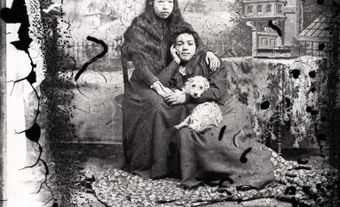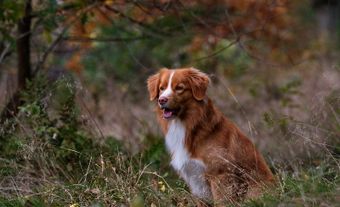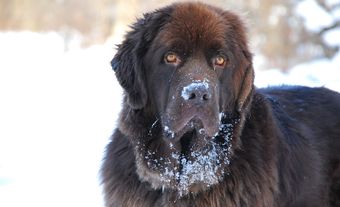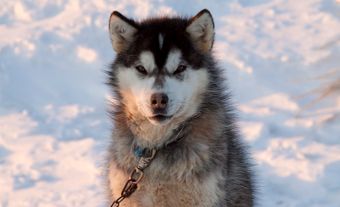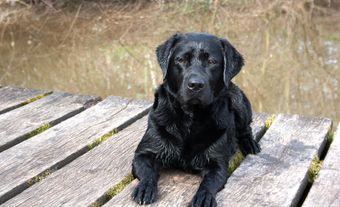Dog (Canis familiaris) is a carnivorous mammal, and probably the first domesticated animal. In Canada, dogs were first kept by Indigenous peoples. The Canadian Kennel Club recognizes 187 breeds, five of which are uniquely Canadian: the Tahltan bear dog, the Canadian Inuit dog, the Nova Scotia duck-tolling retriever, the Newfoundland dog and the Labrador retriever. A sixth dog breed indigenous to Canada, the Salish woolly dog, went extinct before the Canadian Kennel Club officially registered it as a breed.

History
Dogs became domesticated in several different places beginning 10,000 to 20,000 years ago. Their main ancestor was the wolf, though jackals and coyotes may be ancestors as well. These wild species can interbreed with dogs and produce offspring. Despite persistent folk stories, hybridization between dogs and foxes is not successful and foxes cannot be considered ancestral to any dog breed.
Dogs were kept by Indigenous peoples throughout Canada in the centuries before European exploration and settlement. They had various uses: transportation and draft work, hunting, clothing materials and sometimes human food. Inuit dogs are still used to pull sleds and carry backpacks; they are also used in sealing and provide protection from polar bears.
Plains peoples relied on dogs for transportation (e.g., by dog travois) until they acquired horses in the early 1700s. These breeds of dogs are now extinct. On the West Coast, the Salish kept a small, woolly type of dog, using the hair for weaving — it became extinct around 1900. Dogs were also important in religion. For example, the White Dog Festival, observed by some eastern tribes, required the sacrifice of dogs of a special breed.
Did you know?
The Salish woolly dog was a breed kept by Coast Salish peoples in southern Vancouver Island, the Strait of Georgia, and Washington State. The dogs were small and usually white, with long-hair, prick ears, curled tails and fox-like faces. Their hair was mixed with mountain goat hair to produce clothing and blankets. The Salish woolly dog’s population declined throughout the 1800s due to breeding with European dogs, as well as the displacement of the Indigenous peoples who cared for them. By around 1900, the breed was extinct.
Dogs have been an important domestic animal wherever people have settled. Hundreds of distinctive breeds developed over the centuries, partly through regional isolation and partly through conscious selection by humans. Several hundred breeds are currently named and recognized by various kennel clubs; some, for example, poodles, German Shepherd dogs and Irish setters, have worldwide distribution.
Canadian Breeds
The Canadian Kennel Club, which maintains registration records for Canadian purebred dogs, officially recognizes 187 breeds. Several other breeds exist but are not formally registered. The recognized breeds are classified into groups indicating the purpose for which they were developed: sporting dogs, hounds, working dogs, terriers, toys, non-sporting dogs and herding dogs. A miscellaneous category exists for breeds in the process of achieving full recognition.
Five of the breeds recognized by the Kennel Club are uniquely Canadian: the Tahltan bear dog, the Canadian Inuit dog, the Nova Scotia duck-tolling retriever, the Newfoundland dog and the Labrador retriever. The last two have Canadian names but owe most of their development to breeders in Great Britain and Europe.
Tahltan Bear Dog
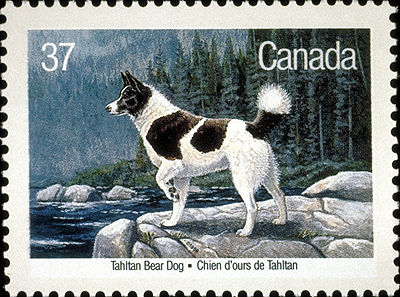
Kept by the Tahltan First Nation of northwestern British Columbia, the Tahltan bear dog was small, probably of the Spitz family, with a foxy head and erect bat ears. Its distinctive, medium-length tail was carried erect and ended in a wide brush. Most were white with black patches. They were used for hunting bear and lynx. The breed was recognized by the Canadian Kennel Club in 1940, but only nine dogs were ever registered. There are none left in Tahltan country, and those that were registered have long since died. Breeders continue to search for survivors, without much hope of success.
Canadian Inuit Dog
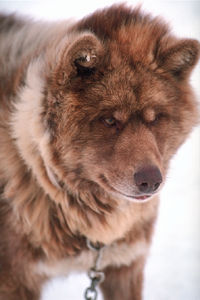
While the Canadian Kennel Club refers to this breed as the “Canadian Eskimo Dog,” the Government of Nunavut calls it the Canadian Inuit dog and made it the territory’s official animal. In Inuktitut the dog is called Qimmiq. Though used historically, the word Eskimo is considered offensive. (See also Eskimo.)
When snowmobiles were introduced to the Arctic, the need for sled dogs rapidly diminished. It soon became evident that the Inuit dogs which had been kept by the Thule for 1,100-2,000 years were facing extinction. The breed had been recognized by the Canadian Kennel Club, but registered stock had not persisted. The Eskimo Dog Research Foundation was formed to re-establish the breed. A few dogs of the original type were obtained from remote Inuit camps in Boothia Peninsula, Melville Peninsula and Baffin Island. They were taken to Yellowknife, Northwest Territories to form the nucleus of a breeding colony. This stock has now been accepted for registration by the Canadian Kennel Club. Many of the dogs have been returned to the Inuit. They are intermediate in speed and strength compared to the Siberian husky and Alaskan Malamute. They are sled and backpack dogs and are useful in hunting.
Nova Scotia Duck Tolling Retriever
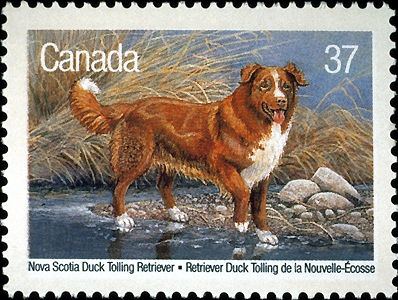
A small breed familiar to Canadians, this retriever is almost unknown in other countries. To “toll” means to entice game to approach by arousing curiosity. A tolling dog is trained to play along the shoreline, attracting inquisitive ducks to swim within gunshot range; the dog is then sent into the water to retrieve the birds. In the late 19th century, a breed with these characteristics was developed in Yarmouth County, Nova Scotia. Several breeds and crosses were used in its development. The dogs are rather foxlike in colour and activity and are intermediate in size and conformation to spaniels and retrievers.
Newfoundlands

Newfoundlands may have originated in dogs kept by Indigenous peoples, or may be traced to dogs brought by the Vikings about 1,000 AD. There probably was later mixture with dogs brought to the island by Basque and Portuguese fishing fleets. British visitors were attracted to the big black dogs and took some of them back to England, where they became very popular. The heavy, long-coated dogs are excellent swimmers and are renowned as family companions and guardians. A black and white variety was depicted by Sir Edwin Landseer in his famous painting A Distinguished Member of the Humane Society, and the variety has since become known as the Landseer.
Labrador Retriever

These dogs, probably from the same stock as the Newfoundland, were shaped into a distinctive breed by the English nobility, who selected them for smaller size, finer bone and a short coat. Other sporting breeds were crossed into the stock. The breed is one of the best gundogs in existence and is used as a "seeing-eye" dog. Most are black but other colours (yellow, chocolate and cream) have become popular.
Dogs in Canada
Most dogs in Canada are kept as pets. Many purebred dogs provide recreation and employment for people participating in competitive events governed by the Canadian Kennel Club. Such competitions include breed shows, obedience trials, field trials for hounds and sporting breeds, tracking tests, and spectator sports such as lure coursing and scent hurdle racing. Sportsmen use various specially bred and trained breeds for hunting upland game birds, waterfowl and small mammals. Greyhounds and wolfhounds are used in western Canada to hunt coyotes and wolves.
Many kinds of dogs perform work for people. Sled dogs are useful in the North. Border collies retain their superiority for sheepherding, and the Komondor breed is being used experimentally in western Canada to guard flocks. Australian cattle dogs, formerly known as Queensland heelers, are gaining popularity with Canadian cattlemen for driving livestock. The German shepherd dog, Doberman pinscher and Bouvier des Flandres are widely used in police and military work and as guard dogs. Schutzhund (protection dog) training is increasing in Canada. It involves intensive schooling in obedience, tracking and defence.
The most remarkable dogs are those trained to guide the blind; several hundred, many from training schools in Ontario and Edmonton, are at work in Canada helping their blind owners to lead more normal lives. Several breeds are used, including German shepherd dogs, Labrador retrievers, boxers and collies.

 Share on Facebook
Share on Facebook Share on X
Share on X Share by Email
Share by Email Share on Google Classroom
Share on Google Classroom

